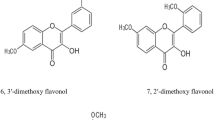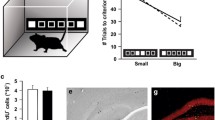Abstract
The consumption of flavonoid-rich foods, in particular fruits and vegetables, has been epidemiologically associated with a reduced risk of heart disease, neurodegenerative disease, cancer and other chronic diseases. Flavonoid glycosides, the main class of flavonoids, have been shown to exert CNS-mediated activities, particularly as sedative-hypnotics, analgesics or both, nevertheless no studies have evaluated these agents in anxiety. This study assessed the potential anxiolytic effect of three flavonoid glycosides, myrcitrin, naringin and gossypin, in the elevated plus maze test (EPM). Myricitrin (1 mg/kg) was effective on the EPM showing a clear anxiolytic effect with no signs of sedation. However, higher doses showed possible sedative and myorelaxation effects. Gossypin and naringin both shared a similar profile, with low doses (1 mg/kg) inducing a robust anxiolytic effect which diminished with increasing doses of the flavonoids. Higher doses of these two flavonoids showed a dramatic increase in the open arm exploration accompanied by a decrease in locomotor activity. Hence, naringin (30 mg/kg) and gossypin (30 mg/kg) induce both anxiolytic and sedative effects. These results suggest that flavonoid glycosides have the potential to exert a range of CNS-mediated biological activities.





Similar content being viewed by others
References
Harborne JB, Williams CA (2000) Advances in flavonoid research since 1992. Phytochemistry 55:481–504. doi:10.1016/S0031-9422(00)00235-1
Havsteen BH (2002) The biochemistry and medical significance of the flavonoids. Pharmacol Ther 96:67–202. doi:10.1016/S0163-7258(02)00298-X
Messina M, Ho S, Alekel DL (2004) Skeletal benefits of soy isoflavones: a review of the clinical trial and epidemiologic data. Curr Opin Clin Nutr Metab Care 7:649–658. doi:10.1097/00075197-200411000-00010
Grendys EC Jr, Blessing JA, Burger R et al (2005) A phase II evaluation of flavopiridol as second-line chemotherapy of endometrial carcinoma: a gynaecologic oncology group study. Gynecol Oncol 98:249–253. doi:10.1016/j.ygyno.2005.05.017
Katsenis K (2005) Micronized purified flavonoid fraction (MPFF): a review of its pharmacological effects, therapeutic efficacy and benefits in the management of chronic venous insufficiency. Curr Vasc Pharmacol 3:1–9. doi:10.2174/1570161052773870
Fernandez SP, Wasowski C, Loscalzo LM et al (2006) Central nervous system depressant action of flavonoid glycosides. Eur J Pharmacol 539:168–176. doi:10.1016/j.ejphar.2006.04.004
Viswanathan S, Sambantham PT, Reddy K et al (1984) Gossypin-induced analgesia in mice. Eur J Pharmacol 98:289–291. doi:10.1016/0014-2999(84)90604-6
Meotti FC, Luiz AP, Pizzolatti MG et al (2006) Analysis of the antinociceptive effect of the flavonoid myricitrin: evidence for a role of the l-arginine-nitric oxide and protein kinase C pathways. J Pharmacol Exp Ther 316:789–796. doi:10.1124/jpet.105.092825
Martínez-Vázquez M, Ramírez Apan TO, Lastra AL et al (1998) A comparative study of the analgesic and anti-inflammatory activities of pectolinarin isolated from Cirsium subcoriaceum and linarin isolated from Buddelia cordata. Planta Med 64:134–137. doi:10.1055/s-2006-957390
Loscalzo LM, Wasowski C, Paladini AC et al (2008) Opioid receptors are involved in the sedative and antinociceptive effects of hesperidin as well as in its potentiation with benzodiazepines. Eur J Pharmacol 580:306–313. doi:10.1016/j.ejphar.2007.11.011
Kissin I, Brown PT, Bradley EL Jr (1990) Sedative and hypnotic midazolam-morphine interactions in rats. Anesth Analg 71:137–143
Zarrindast MR, Rostami P, Zarei M et al (2005) Intracerebroventricular effects of histaminergic agents on morphine-induced anxiolysis in the elevated plus-maze in rats. Basic Clin Pharmacol Toxicol 97:276–281. doi:10.1111/j.1742-7843.2005.pto_116.x
Shin IC, Kim HC, Swanson J et al (2003) Anxiolyic effects of acute morphine can be modulate by nitric oxide systems. Pharmacology 68:183–189. doi:10.1159/000070457
Agmo A, Galvan A, Heredia A et al (1995) Naloxone blocks the antianxiety but not the motor effects of benzodiazepines and pentobarbital: experimental studies and literature review. Psychopharmacology (Berl) 120:186–194. doi:10.1007/BF02246192
Filliol D, Ghozland S, Chluba J et al (2000) Mice deficient for delta- and mu-opioid receptors exhibit opposing alterations of emotional responses. Nat Genet 25:195–200. doi:10.1038/76061
Knabl J, Witschi R, Hösl K et al (2008) Reversal of pathological pain through specific spinal GABAA receptor subtypes. Nature 451:330–334. doi:10.1038/nature06493
Pick CG (1997) Antinociceptive interaction between alprazolam and opioids. Brain Res Bull 42:239–243. doi:10.1016/S0361-9230(96)00265-1
Fernandez SP, Mewett KN, Hanrahan JR et al (2008) Flavan-3-ol derivatives are positive modulators of GABA(A) receptors with higher efficacy for the alpha(2) subtype and anxiolytic action in mice. Neuropharmacology 55:900–907. doi:10.1016/j.neuropharm.2008.06.069
File SE (2001) Factors controlling measures of anxiety and responses to novelty in the mouse. Behav Brain Res 125:151–157. doi:10.1016/S0166-4328(01)00292-3
Bonetti EP, Pierri L, Cumin R et al (1982) Benzodiazepine antagonist RO 15–1788: neurological and behavioral effects. Psychopharmacology (Berl) 78:8–18. doi:10.1007/BF00470579
Ashton CH (2003) Insomnia and anxiety. In: clinical pharmacy and therapeutics, 3rd edn. Churchill Livingstone, Sydney, pp 423–438
Ipser JC, Carey P, Dhansay Y, et al. (2006) Pharmacotherapy augmentation strategies in treatment-resistant anxiety disorders. Cochrane Database Syst Rev CD005473
Cryan JF, Holmes A (2005) The ascent of mouse: advances in modelling human depression and anxiety. Nat Rev Drug Discov 4:775–790. doi:10.1038/nrd1825
Marder M, Paladini AC (2002) GABAA-receptor ligands of flavonoid structure. Curr Top Med Chem 2:853–867. doi:10.2174/1568026023393462
Zitron E, Scholz E, Owen RW et al (2005) QTc prolongation by grapefruit juice and its potential pharmacological basis: HERG channel blockade by flavonoids. Circulation 111:835–838. doi:10.1161/01.CIR.0000155617.54749.09
Kobayashi T, Ikeda K, Ichikawa T et al (1995) Molecular cloning of a mouse G-protein-activated K+ channel (mGIRK1) and distinct distributions of three GIRK (GIRK1, 2 and 3) mRNAs in mouse brain. Biochem Biophys Res Commun 208:1166–1173. doi:10.1006/bbrc.1995.1456
Guasti L, Cilia E, Crociani O et al (2005) Expression pattern of the ether-a-go-go-related (ERG) family proteins in the adult mouse central nervous system: evidence for coassembly of different subunits. J Comp Neurol 491:157–174. doi:10.1002/cne.20721
Chu CP-Y (2006) Three Pharmacological studies on nicotinic acetylcholine receptors: β-amyloid peptides, flavonoids and α-conotoxins. Ph. D Thesis, University of Sydney, Sydney
Picciotto MR, Brunzell DH, Caldarone BJ (2002) Effect of nicotine and nicotinic receptors on anxiety and depression. NeuroReport 13:1097–1106. doi:10.1097/00001756-200207020-00006
Meotti FC, Posser T, Missau FC et al (2007) Involvement of p38MAPK on the antinociceptive action of myricitrin in mice. Biochem Pharmacol 74:924–931. doi:10.1016/j.bcp.2007.06.024
Walle T (2004) Absorption and metabolism of flavonoids. Free Radic Biol Med 36:829–837. doi:10.1016/j.freeradbiomed.2004.01.002
Manach C, Williamson G, Morand C et al (2005) Bioavailability and bioefficacy of polyphenols in humans. I. Review of 97 bioavailability studies. Am J Clin Nutr 81:230S–242S
Bokkenheuser VD, Shackleton CH, Winter J (1987) Hydrolysis of dietary flavonoid glycosides by strains of intestinal bacteroides from humans. Biochem J 248:953–956
Day AJ, DuPont MS, Ridley S et al (1998) Deglycosylation of flavonoid and isoflavonoid glycosides by human small intestine and liver beta-glucosidase activity. FEBS Lett 436:71–75. doi:10.1016/S0014-5793(98)01101-6
Day AJ, Canada FJ, Diaz JC et al (2000) Dietary flavonoid and isoflavones glycosides are hydrolysed by the lactase site of the lactase phlorizin hydrolase. FEBS Lett 468:166–170. doi:10.1016/S0014-5793(00)01211-4
Tsai TH (2002) Determination of naringin in rat blood, brain, liver, and bile using microdialysis and its interaction with cyclosporin a, a p-glycoprotein modulator. J Agric Food Chem 50:6669–6674. doi:10.1021/jf020603p
Peng HW, Cheng FC, Huang YT et al (1998) Determination of naringenin and its glucuronide conjugate in rat plasma and brain tissue by high-performance liquid chromatography. J Chromatogr A 714:369–374
Acknowledgments
The authors are indebted to Dr. Alejandro A. Paladini (INGEBI, Buenos Aires, Argentina) for designing the behavioural apparatus. This research was supported by a grant from the National Health and Medical Research Council (NH&MRC) of Australia.
Author information
Authors and Affiliations
Corresponding author
Rights and permissions
About this article
Cite this article
Fernandez, S.P., Nguyen, M., Yow, T.T. et al. The Flavonoid Glycosides, Myricitrin, Gossypin and Naringin Exert Anxiolytic Action in Mice. Neurochem Res 34, 1867–1875 (2009). https://doi.org/10.1007/s11064-009-9969-9
Received:
Accepted:
Published:
Issue Date:
DOI: https://doi.org/10.1007/s11064-009-9969-9




